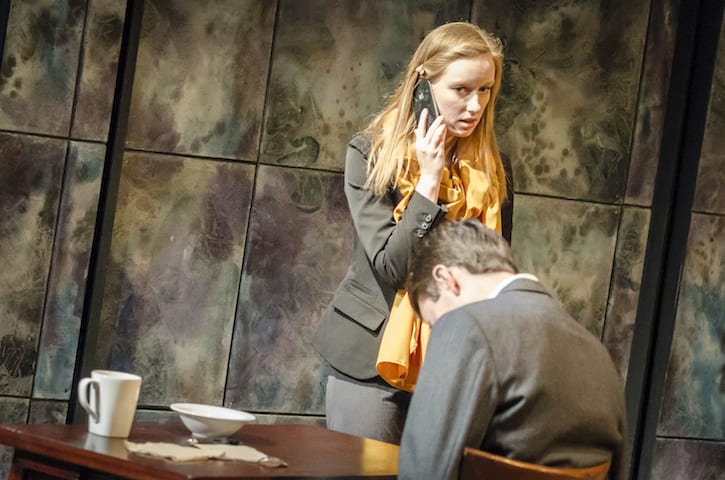
The St. Olaf Theatre Department’s newest show, Dead Man’s Cell Phone by Sarah Ruhl, premiered on Thursday, March 12. The run concluded on Sunday, March 15. The production was directed by Shannon Cron ’15, keeping with the department’s annual tradition of a senior theatre major directing one of the season’s shows.
Dead Man’s Cell Phone told the story of a young woman named Jean Katie Hindman ’15 who finds herself caught up in a surreal journey that blurs the lines between comedy, tragedy and romance after she repeatedly answered the phone of a man that died next to her at a cafe. The playmakers gave themselves an excellent gift in their selection of Ruhl’s beautiful narrative exploration of mortality and human connection.
Building upon the foundation laid by the script, the play continued to impress with its technical aspects. The visually striking set was symmetrical and minimalist, allowing it to serve as the location for a wide variety of scenes with little more than a few changes of furniture. Whether it was a nondescript cafe, a stationery store or a Johannesburg airport, the set always felt like the perfect backdrop for the show’s tone.
The production’s often dim lighting seemed at home in the Theater Building’s smaller stage, Haugen Theater. Dead Man’s Cell Phone was the first play this year, either Department or Deep End APO production, to use Haugen. The venue choice matched the smaller scale of the show, as opposed to the grandness of last month’s Cymbeline or the upcoming Big Fish, both of which chose the much more spacious Kelsey Theater as their venue.
This is not a knock against Dead Man’s Cell Phone, however. The play was only smaller in terms of scope. The script called for a world that appeared to be vacant apart from the main cast. There is a distinct void of ancillary characters. Jean finds a dead man in a cafe and remarks on how the place is completely empty, despite purchasing soup there just minutes before. When Jean is later held up at gunpoint in an airport, there is no fuss and no intervention. In the funeral scene, there is no reference to any attendees we don’t see. The closest we get is a grieving mother attempting to hug various members of the audience. Just as no one sees the owner of the cell phone pass away, no one sees anything that happened to the characters in the play.
No one outside of the story has any stake in the fate of the characters. The world would not have stopped if Jean actually had died in the second act. The mother’s grieving has no impact on the society around her. Even the dead man’s black market organ trade empire is able to move on without him. In Cymbeline, we saw personal conflicts lead to a clash of Britons versus Romans played out on the fields of war. Conversely, this show seems to have much lower stakes, which actually provides the true magic of the play. In a world without witnesses, the audience becomes the sole witness. We feel a responsibility to invest in these characters because no one else could.
Another interesting aspect of the show was the set changes. Rather than having blackouts, the audience watched as the stage hands moved the props around for the next scene. To keep this entertaining, transitions were accompanied by a catchy electro-swing tune. In a comic twist, the stage hands did all of their work rather begrudgingly as they scoffed at the inhabitants of the play’s decidedly empty world. The joke never really progressed, unfortunately, but it was still interesting to see how various characters interacted with the stage hands as they all flurried about the stage, getting in each other’s ways.
The play’s acting was top-notch all around. As the protagonist, Hindman was wonderfully quirky, able to bring the audience to laughs with the subtlest of movements. Her chemistry with love interest Dwight Joey LeBrun ’15 was very nice and brought a lot of heart to the show. It was a joy to see Jean’s reactions to the play’s eccentric characters, from an awkward conversation with the dead man’s snooty wife Stacie Argyrou ’16 to wrestling for a gun with a stranger at the airport Emily Field-Olson ’16.
The dead man’s mother, Mrs. Gottlieb Christa Schmidt ’16, was probably the funniest character in the show. Schmidt had the audience in stitches every time she waddled on stage wailing about whatever it was upsetting her that minute. Though the character was absurd, Schmidt was able to make Mrs. Gottlieb believable within the world of the play, even as she ran into a large outdoor grill to meet her son in the afterlife.
The biggest show-stealer, however, was none other than the titular dead man himself, Gordon Dylan Stratton ’16. Though we did not get to see much of Stratton in the first act, other than his impressive ability to sit still for lengthy periods, he opens the second act with hilarious and heartfelt monologue reflecting on his last day alive. In a way, Stratton actually played two characters: the actual, flawed but lovable Gordon, and then later a much meaner, vicious Gordon in Jean’s nightmare. Stratton displayed expert acting versatility not only in these variations of his character, but also in his ability to seamlessly switch between rib-tickling humor and heart piercing drama.
I don’t usually like to give glowing reviews; having no criticisms makes me feel like I’m not doing my job right. But other than maybe the choreography of the one fight scene being a tad hit-or-miss literally and figuratively, I don’t really have any complaints. Dead Man’s Cell Phone was a wonderful play and the best show of St. Olaf’s theater season so far.
The next department show is Big Fish, which premieres April 9, and runs until April 12. Tickets are available now in the box office and online.
mayo1@stolaf.edu
Photo Credit: ANDREW WILDER/MANITOU MESSENGER

